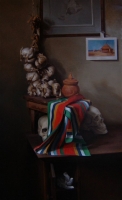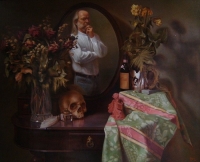Vanitas
Vanitas is a style of still life painting in which the various objects depicted symbolize the brevity and vanity of human existence and the transience of human pleasures and can include mirrors, timepieces, scales, human skulls, flowers, butterflies, candles and books. The stages of existence in a flower for instance, would sometimes by depicted in one painting by showing the bud, full bloom and a scattering of petals.
Vanitas—a popular genre in Western Europe in the 16th and 17th centuries, especially in the Netherlands—was later revived by some of the 19th century Post-Impressionists as well as some 20th century Modernists. This style was also incorporated into figure paintings with the same allegorical implications by such artists as Georges de La Tour, who depicted Mary Magdalene in front of a mirror with a candle and skull. Vanitas symbols are also found in works by Gaugin, Cezanne, Braque and Picasso.
This realm of painting applies itself very well to our life and times. The constant motion of the conscious and unconscious as it weaves itself through our lives on a daily basis with all sorts of hidden meaning, the Judeo-Christian background at its core. The continued effort to expand on the repertoire of this style of painting is me and my life—the Kapsner signature.
The imagery I create, whether through portraiture, still lifes or fresco, encourages the viewing audience to explore beyond their own immediate surroundings and invites them—through self-reflection—to more fully appreciate the beauty of the adornments of daily life while pondering the possibilities that lie ahead.





